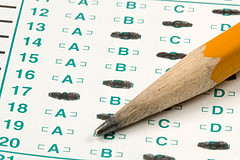On May 24th, Superint endent of Public Instruction, Chris Reykdal outlined a series of phases that addressed his long term vision for K-12 education in the State of Washington. Included in
endent of Public Instruction, Chris Reykdal outlined a series of phases that addressed his long term vision for K-12 education in the State of Washington. Included in
that vision is a differentiated assessment model that allows students pathways to demonstrate proficiency and mastery. The plan calls for an immediate suspension of all test based graduation requirements for the Classes of 2017, 2018, and 2019, a policy that some legislators can get behind. (See the June 4, 2017 Seattle Times Op-Ed piece by Rep. Monica Stonier and Rep. Laurie Dolan) This agenda item isn’t necessarily as visionary as others but is more triage in nature. Asking for these assessments to be waived now is a pressing concern for our potential graduates waiting in the wings (including the 7 students at my high school who are hoping that the state legislature acts immediately since graduation is on Friday, June 9th). However, other components of this assessment system provide more opportunity and greater steering towards a student’s plans for high school and beyond.
One of the key takeaways from this plan is the use of assessment data for high school planning. Superintendent Reykdal proposes that the 8th grade assessment (assuming this will still be mandated by the U.S. Department of Education) be used to determine what courses and in what sequence students need to take. A 10th grade assessment (the Standards Based Assessment, or SBA, also mandated by the U.S. Department of Education) would further clarify what students need in order to be career and college ready. That exam, while not necessary as a graduation requirement, would be a baseline for which other decisions would be made. The assessment would help stakeholders update a student’s high school and beyond plan (commonly referred to as a HSBP), either demonstrating that is student is now proficient in the required basic knowledge and skills needed to earn a diploma or highlighting what specific skills students need to further develop in order to achieve proficiency. The plan suggests that alternatives such as the SAT, ACT, Advanced Placement exams, International Baccalaureate exams, Running Start, College in the High School, and other options be used to demonstrate proficiency. All students after 10th grade must work towards a pathway that includes immediate entrance into the workforce, technical college, community college, apprenticeships, four year colleges/university, or the military.
This new assessment system may just help us combat the apathy that emerges junior and senior year from students wondering why they are enrolled in certain courses that don’t remotely relate to their post secondary education plans. Such a plan opens the door to exciting new classes tailored to meet the needs of the 21st century learner on whatever pathway he/she may be on. High schools will be able to utilize the flexibility and creativity that this system promotes and adjust current course offerings, tapping into the talents and expertise of their staff. The idea that students can select pathways and prepare for those future careers allows students more buy in on their secondary education, potentially impacting overall attendance, number of failed classes, and eventually graduation rates. Specific training and coursework geared towards a pathway will indeed result in a better worker or stronger college student thus largely impacting the state’s post secondary education system and the local workforce. Superintendent Reykdal’s proposal directly impacts students allowing them to tap into their talents and interests at an earlier age so that they may develop as stronger, more effective and more efficient contributors to our communities and overall economy.

 er learning. Yet, it didn’t occur to me until recently to build a bridge. Perhaps that’s what my work is now. I’m an engineer–creating bridges between my classroom and my state policymakers.
er learning. Yet, it didn’t occur to me until recently to build a bridge. Perhaps that’s what my work is now. I’m an engineer–creating bridges between my classroom and my state policymakers.

